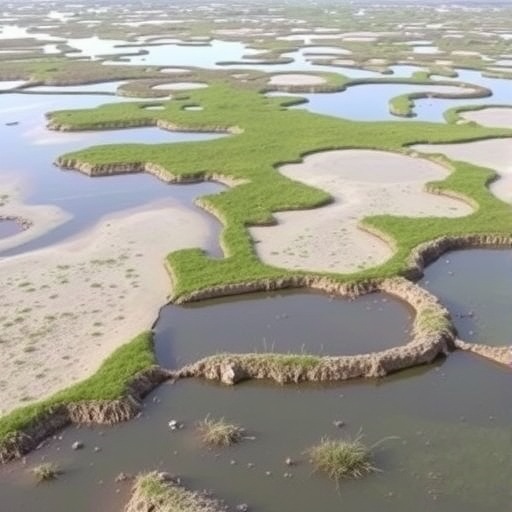The coastal regions of Odisha, India, have recently drawn the attention of ecologists and researchers due to their unique ecosystems, particularly the saltmarshes that dot the coastline. A new study conducted by A.K. Mishra and S.H. Farooq has illuminated how local environmental factors impact the distribution and population structures of these vital ecological zones. As climate change continues to pose threats to coastal habitats globally, the findings from this research may help us understand the resilience of saltmarshes in Odisha and offer insights for conservation strategies.
Saltmarshes serve as critical interfaces between terrestrial and marine ecosystems, playing a significant role in carbon sequestration, providing habitat for diverse species, and protecting shorelines from erosion. However, these ecosystems are highly sensitive to various factors, including salinity, temperature, and local hydrology, which can vary dramatically across different geographic regions. The authors aimed to investigate how these local factors influence the health and distribution of saltmarshes along the Odisha coast.
One of the primary concerns highlighted in the study is the increasing salinization of coastal environments, exacerbated by sea-level rise and altered precipitation patterns linked to climate change. These changes can significantly affect the flora found in saltmarshes, as many plants in this ecosystem have evolved specialized adaptations to cope with saline conditions. The findings suggest that salinity levels, driven by both natural and anthropogenic factors, influence the species composition and distribution patterns that define the coastal landscape.
Temperature fluctuations also play a crucial role in shaping saltmarsh ecosystems. Mishra and Farooq emphasize that both daily and seasonal temperature variations can impact plant growth and reproductive success. During their research, they observed a correlation between temperature averages and the diversity of saltmarsh plant species. This suggests that as global temperatures rise, the ability of certain species to thrive in these marshes may diminish, further impacting ecological balances.
Hydrological regimes, including tidal influences and freshwater inflow, are also critical in maintaining saltmarsh health. The authors found that areas with optimal hydrology supported a richer diversity of saltmarsh flora and fauna. Irregularities in tidal flows due to human activities, such as dam construction and water extraction, can lead to habitat degradation, which is a significant concern for local biodiversity. Their findings indicate that maintaining natural hydrological processes is essential for the sustainability of saltmarshes.
Moreover, the study highlights the importance of local topography in influencing how seawater and freshwater interact in coastal environments. The researchers identified specific landforms, such as bays and tidal flats, which serve as unique niches for distinct plant communities. Understanding the interplay between these geomorphic features and saltmarsh distribution can aid in effective habitat management and restoration efforts.
Another central focus of the research was the anthropogenic impacts that threaten the delicate balance of saltmarsh ecosystems. Urban development, industrial activities, and agricultural encroachment often lead to habitat loss and fragmentation. Mishra and Farooq stress the importance of integrating conservation strategies to mitigate these impacts, emphasizing that both governmental and community action is vital in preserving saltmarsh habitats for future generations.
The authors also examined the influence of local biodiversity on overall ecological resilience. They found that diverse saltmarsh plant communities demonstrate greater stability and adaptability to environmental stressors. This observation underlines the significance of conserving species diversity as a means of bolstering ecosystem resilience against climate change. The researchers advocate for more significant investments in biodiversity monitoring and conservation initiatives along the Odisha coast.
As part of their research methodology, the authors conducted field surveys to collect data on plant species richness, distribution patterns, and local environmental conditions. Their comprehensive approach involved collaborative efforts with local communities, which fosters a sense of ownership and responsibility towards environmental stewardship. Engaging local populations in scientific research can enhance conservation outcomes by leveraging indigenous knowledge and practices.
The implications of this study extend beyond the shores of Odisha. The exploration of local factors that influence saltmarsh ecosystems provides valuable insights that may apply to other regions facing similar ecological challenges. Policymakers and conservationists can utilize these findings to inform management plans that prioritize ecosystem resilience and biodiversity.
Moreover, the potential applications of this research are timely, considering the global urgency surrounding climate change adaptation strategies. Weeks after the study’s release, various environmental organizations have already cited its findings in discussions about sustainable coastal development and habitat restoration efforts. Awareness of the critical role of saltmarshes in climate mitigation efforts is increasingly becoming a focal point in environmental policy.
Further research is suggested by the authors to explore long-term trends in saltmarsh health and how shifting climatic conditions might further alter these unique ecosystems. Longitudinal studies that observe changes over time can provide more comprehensive insights into the adaptive capacities of various plant species and inform future conservation efforts.
In conclusion, the study by A.K. Mishra and S.H. Farooq represents an essential step toward understanding the complex dynamics of saltmarsh ecosystems in Odisha. Their findings shine a light on the intricate relationships between local environmental factors and plant populations, highlighting the necessity for informed conservation strategies in the face of escalating climate impacts. As communities and policymakers grapple with ecological challenges, research like this will be crucial in rallying efforts to protect our planet’s valuable coastal ecosystems.
Subject of Research: Saltmarsh distribution and population structure influenced by local factors along the coast of Odisha, India.
Article Title: Influence of local factors on saltmarsh distribution and population structure from the coast of Odisha, India.
Article References:
Mishra, A.K., Farooq, S.H. Influence of local factors on saltmarsh distribution and population structure from the coast of Odisha, India.
Discov. Plants 2, 215 (2025). https://doi.org/10.1007/s44372-025-00239-8
Image Credits: AI Generated
DOI: 10.1007/s44372-025-00239-8
Keywords: saltmarshes, Odisha, climate change, biodiversity, ecological resilience, conservation strategies




